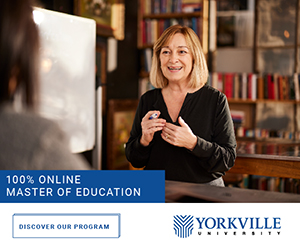Over the years, various technologies I encountered at professional development opportunities peaked my interest. I would go home and plan, what I believed was, a thought-provoking and engaging lesson that embedded the new technology. My excitement and anticipation could not be contained as students walked into the classroom. On a number of occasions, though, the result was unanticipated and disappointing. Students were uninterested, detached, and not compelled to engage with the technology in the way that I had hoped. The activity that I thought would take the entire class period resulted in accessing my “teacher’s toolbox” to modify the lesson, as the students waited. It is moments like these that led to my desire to explore student engagement and the use of digital technologies in the classroom. I have personally seen digital technology engage students in activities and lessons. I have seen the power of the technology to engage students who were previously resistant to learning and, as a result, I believe that digital technology has the potential to engage students. However, why then does digital technology sometimes engage students and at other times disengage them?
We are immersed in technology, and classrooms are no exception. With the prevalence of the use of digital-technology use in classrooms, it is important to understand how digital technology engages or disengages students.
Student Engagement
As a classroom teacher, I seek to engage my students. When I talk with my colleagues, it is clear that we all define and assess student engagement in different ways. The research literature is no different and reflects the complexity of student engagement in theory and in practice. It is important to understand what student engagement is and is not, and to identify observable characteristics of student engagement.
The word engagement is often used synonymously with words such as motivation and effort. The challenge as classroom teachers is how do we see motivation and effort? As such, my research defined engagement as:
involvement in class discussions, participating in learning activities, asking questions, responding to other comments, marking in their texts, debating, bringing questions and problems to the class that were discovered by reading out of class, writing response papers, emailing or posting discussion thread questions and comments with other texts and writers, and probing deeply into a text or a research problem” (Garrett, 2011, p. 6).
This definition was chosen because of the observable indicators that would allow me to see engagement.
Technology
There is a lot of research on digital technology and classroom practice. There is research that sees technology as an asset to the classroom. It suggests that incorporating technology into the classroom prepares students for the future, provides opportunities for communication and collaboration, exposes students to different global perspectives, and fosters student control and responsibility for learning. On the other hand, there is research that suggests that technology is a hinderance to the classroom because digital texts are complex and multimodal leading students to feel brain overload. This overload chips away at student’s ability to concentrate and think leading them to rush through their work.
One thing everyone can agree upon whether you’re a researcher, classroom teacher, or parent is that digital technology permeates our lives and, as such, permeates our classrooms influencing the way we teach, and the way students engage, learn and achieve. As such, trying to ignore the influence by restricting technology in the classroom isn’t realistic. Instead, we need to understand how to leverage it to use it as a tool to engage students in the classroom learning.
Lessons to Teach by
By situating myself in a grade 11 English classroom for an entire semester, I was able to be a participant observer. I maintained field notes and a reflective journal while students completed questionnaires, engaged in conferences with me, and participated in focus group conversations all while continuing to participate in the classroom learning. I was able to intertwine the rich data acquired through the ethnography to create a list of lessons to teach by.
Lesson 1: Step Away from the Slideshow
“If technology is used to give information at you to just regurgitate and retain, then technology should not be used as part of the teaching process” (Grade 11 student participant).
Students want the teacher to teach through conversation, writing on a whiteboard or chart paper, and by creating activities. If students want to learn through technology, they would choose an online course. Students choose to be in class to learn from and with the teacher and they assert that the teachers need to teach rather than relying on the technology to teach. Many students were actually supportive of excluding technology from lessons citing that they want the teacher to talk and show rather than to present ready-made information. Students feel like if the teacher wants to use technology, it should be left for practice or reinforcement of a lesson. In other words, technology should not be included within the lesson but, instead, it could be included after the lesson.
Try this: When giving a lesson, project a single image. Use that as the visual prompt for the topic of the lesson. It will act as a cue for visual learners and as a memory prompt when students have to recall the lesson.
Lesson 2: Invite Thinking
“I like being able to come up with different types of ideas…things that we didn’t discuss in class” (Grade 11 student participant).
Students thrive when they experience and interact with the curriculum to seek out information about which they are curious about. When technology affords students autonomy to synthesize, interpret, and hypothesize so they can create personal meaning, students appear to be actively engaged. When technology is used for knowledge construction, rather than knowledge consumption, the technology will support engagement.
Try this: Ask students an open-ended question that has an infinite number of answers and then allow them to use technology to read, search and explore in order to find their own answer to the question. Questions like “What is the most important news event of the year?” or “What is the best campaign poster?” or “Who presented the most compelling speech at the event?” are questions that lead students to inquire but then to also share and debate with each other.
Lesson 3: Create Connection
“I like being able to share my GoogleDoc with the teacher so she can look at it…I like that I can connect with other people in the class by working on a single document at the same time” (Grade 11 student participant).
Students are meaningfully engaged when they participate in learning activities through interaction with others. Using technology should not isolate students but involve them in collaborative and constructive communication. Students want two-way opportunities to interact, collaborate, explore, understand, and share ideas with each other, their teacher, and the global world. Technology use should involve students in collaborative communication by creating a space to engage in virtual conversation.
Try this: Have students post their work on a classroom blog for their peers to read and post comments on. The comments can be used as assessment feedback for the writer to improve their work before posting it on a global website so it reaches a wider audience.
Lesson 4: Allow for Movement
“When I’m standing in the class, I never take out my device because then everyone will see me. It would be rude to be on my phone when I’m supposed to be doing an activity” (Grade 11 student participant).
Tasks that allow students to leave their seats and move around engage students and prompts them to resist the allure of technology. Not only do students participate in the task, but they smile and laugh which are all indicators of enjoyment. Students know that living in a digital world means that they need to learn how to responsibly use their technology and they want to learn life strategies to manage their use. Creating opportunities for them to unplug by engaging them in active movement prompted students to not lose focus or detach from the task by interacting with their personal technology. The classroom should also include intentionally-planned opportunities for students get up and walk away from their technology.
Try this: Have students work in small groups standing at a piece of chart paper posted on the wall. Post an idea or image or question for students to reflect on and then, as a group, have them write their ideas on the paper before moving on to the next chart paper. This rotation between stations gets the students collaborating and moving before they return to their desks to consolidate their ideas or move through the next step in the task that may include using technology.
Conclusion
Technology alone does not lead to student engagement. Instead, it is simply a tool to engage. What’s important to consider is the outcome of the technology. When the interaction with technology allows students to access information to construct their own ideas so they can draw their own conclusions, the technology will support student engagement. When technology is used in a way to have students consume and absorb information, the technology will disengage them. The best thing we can do as classroom teachers is to allow technology to be a tool that allows students to access information so that they can develop their own ideas.
References
Garrett, C. (2011). Defining, detecting, and promoting student engagement in college learning environments. Transformative Dialogues: Teaching and Learning Journal, 5(2), 1–12.
AUTHOR BIO:
Dr. Sunaina Sharma is an in-school program leader and secondary teacher with over twenty years experience teaching in Burlington, ON. She strives to put the learner’s needs at the forefront of all program planning, classroom teaching, and professional learning so that students are participating in authentic and relevant knowledge construction. Her doctoral research centred on understanding how to leverage digital technology in the classroom so that it supports student engagement.












